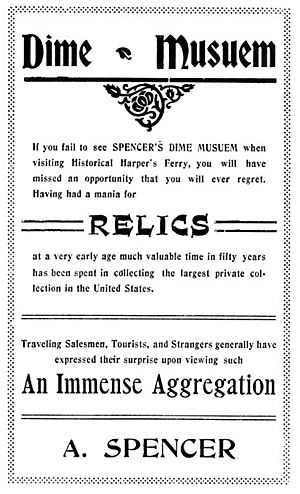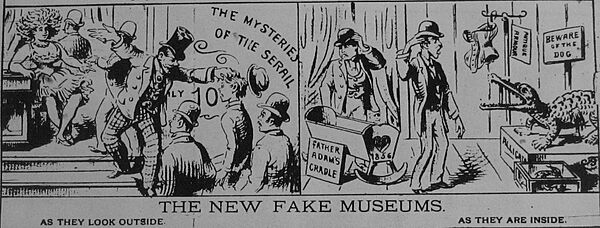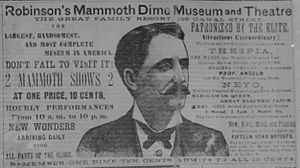Dime museum facts for kids
Dime museums were exciting places that became very popular starting in 1870. For just a dime, people could see all sorts of interesting things. These museums showed off unusual performers, displays about the human body, detailed scenes called dioramas, and strange objects. They also offered talks that taught lessons about life.
These museums were most popular in the United States during the late 1800s. They were designed to be fun and educational for working-class people. This made them different from the more formal cultural events enjoyed by wealthier people. In big cities like New York City, where many immigrants lived, dime museums offered cheap and popular entertainment. This trend was at its peak during the Progressive Era (around 1890–1920). Many famous vaudeville entertainers, like Harry Houdini, Lew Fields, and Joe Weber, actually started their careers in dime museums.
Contents
A Look Back: How Dime Museums Started
Dime museums appeared during a special time in American history. Cities were growing quickly and becoming home to many different kinds of people. Working and middle-class families had more free time because of new ways of producing goods. They needed new ways to have fun, and dime museums became a popular choice for everyone.
Dime museums took some ideas from earlier "freak shows." These shows, which began in Europe in the early 1800s, also offered mass entertainment. However, freak shows often treated the people they displayed unfairly. They would show people from different cultures or those with unusual bodies as spectacles. They often made these individuals seem strange or exaggerated stereotypes.
Dime museums were open to anyone who could pay the small entrance fee. They offered wild entertainment but also tried to teach visitors new things. This educational side was a key part of their appeal. Over time, other forms of entertainment became more popular. Amusement parks, better movies, and vaudeville shows offered fresh experiences. People eventually preferred these new options over the familiar sights of dime museums. By the time of World War I, dime museums were mostly just a memory.
Famous Dime Museums Across America
Dime museums popped up in many cities across the United States. Each one had its own unique attractions and stories.
San Francisco's Unique Exhibits
One of the longest-running dime museums in San Francisco was the Pacific Museum of Anatomy and Natural Science. An early exhibit there featured the preserved head of Joaquin Murrieta. He was a famous Mexican outlaw who fought against Western expansion. Dime museums also showed how different people's bodies could be. In 1895, Milton B. Matson worked at a San Francisco dime museum. Matson performed by sitting on a platform while wearing men's clothing to earn money.
San Francisco also had the Museum of Living Wonders and Woodward's Gardens. These were located in different parts of the city.
Baltimore's Early Museums
In Baltimore, Maryland, Peale's Museum is known as one of the country's first serious museums. Later, in 1999, the American Dime Museum tried to bring back this type of attraction. It operated for eight years before closing in 2007.
Boston's Rival Attractions
Kimball's Museum and Austin & Stones Museum were popular spots in Boston. Kimball's Museum often worked with, and sometimes competed against, P. T. Barnum. Barnum and Moses Kimball even shared famous exhibits like the ""Fee Gee Mermaids"" with each other.
Cincinnati's Wax Figures
In Cincinnati, the Western Museum was started in 1818. Both John James Audubon and sculptor Hiram Powers created displays for it. One famous exhibit featured "Satan and his Court" wax figures. These figures had moving parts and glowing eyes, which was very exciting for visitors.
New Orleans' Musical Shows
On Canal Street in New Orleans, "Eugene Robinson's Museum and Theater" offered entertainment every hour. Some of its shows were even on a nearby riverboat. These dime museums often had brass bands playing outside to attract people. These bands helped start early traditional jazz music. Robinson's riverboat museum even hired Papa Jack Laine, a famous musician.
New York City's Entertainment Hubs

P. T. Barnum bought Scudder's Dime Museum in 1841. He turned it into Barnum's American Museum, one of the most famous cultural spots ever. Barnum and Moses Kimball introduced "Edutainment." This was a way to teach moral lessons through exciting shows, theater, and circus acts. Barnum's first museum burned down in 1865. It moved to a new location, but that one also caught fire.
For many years, Hubert's Museum was in the basement of the Playland Arcade in Times Square, New York City. It featured acts like Lady Estelene, a sword swallower, and Congo The Jungle Creep. It also had a flea circus and magicians. Later, another dime museum opened in Times Square. It featured performers like Tisha Booty, "the Human Pin Cushion," and several magicians.
Chicago's Growing Scene
In 1882, C. E. Kohl and Middleton opened their first Dime Museum in Chicago. It was located on West Madison Street. They opened two more museums in Chicago in 1883, showing how popular these places were becoming.
See also
 In Spanish: Dime museum para niños
In Spanish: Dime museum para niños



